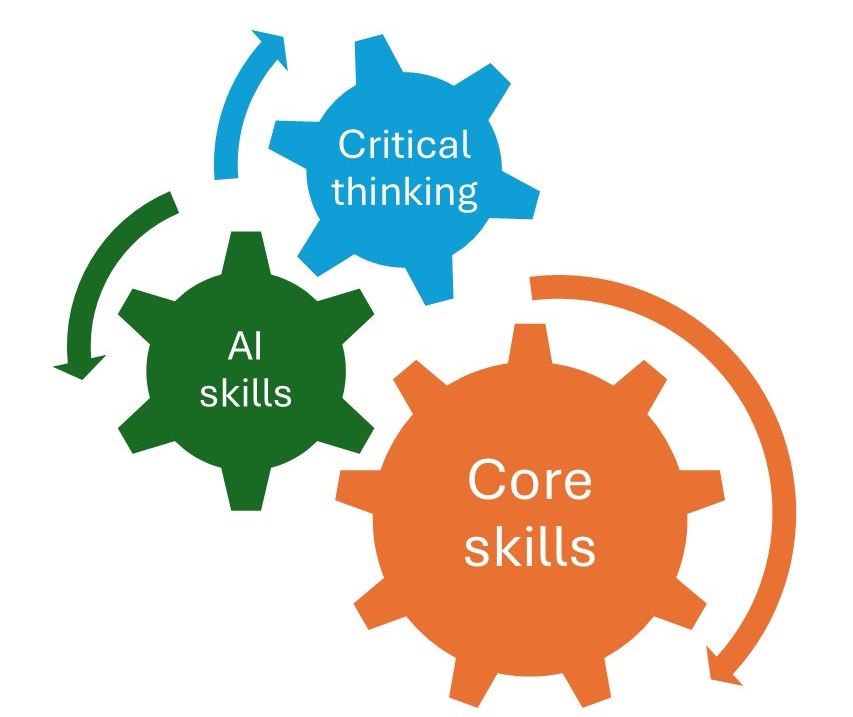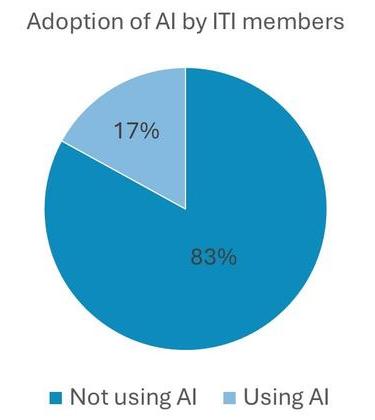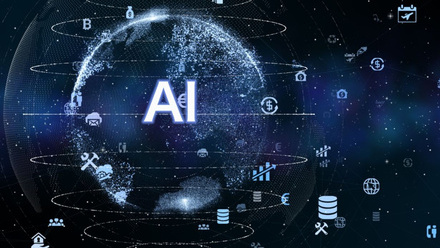Artificial Intelligence
Generative AI and other emerging technologies have developed rapidly over the last year or so, resulting in considerable hype in the media. This has generated both a degree of pessimism, as well as more useful and considered thinking.
Key issues facing the language services sector
There is a risk that public perception of the value of linguistic skills may decline but, on the other hand, there is an opportunity to highlight the considerable expertise offered by language professionals operating in specialist sectors. Having participated in a wide range of sector discussions in recent months it seems that there is a growing consensus that the key issues for the language services sector are likely to centre on the following themes:
- The human is, and will continue to be, essential to ensuring high quality, accurate and ethical translation and interpreting outcomes
- The evolution and regulation of generative AI technologies is out of our control, but we might need to selectively challenge some developments
- New models of working could offer the potential for new commercial opportunities and diversification
- Much more content will (need to) be translated in the future
- The most skilled linguists will be in greatest demand i.e. commercial success will lie in specialisation rather than generalisation.
ITI's response
The Board recognises the importance of this topic and is actively monitoring develeopments in the sector. We are also committed to supporting members in a number of ways:
- Continuing to champion the value of human translators and interpreters
- Ensuring that the Board has access to knowledge and experience to support informed decision-making
- Supporting ITI members to learn about generative AI tools and how to use them to enhance and adapt their businesses
- Seeking out opportunities to collaborate with other organisations on shared initiatives in this policy area.
AI Working Group
The Board also set up a working group in the autumn of 2023 and appointed Iwan Davies as its chair. The working group made its first report to the Board in September 2024. The report can be downloaded below and the summaries of the discussions can be found in the table.
Generative AI in translation and interpreting education
Discussion leader: Ramon Inglada, Associate Professor in Spanish and Translation Technologies | Head of Learning and Teaching (LINCS) | ITI ScotNet Convenor
Introduction
The rapid advancement of generative AI technologies, particularly large language models like ChatGPT, has sparked significant changes and debates in higher education. This summary, based on a presentation and discussion by translation and interpreting experts, explores the impact of these technologies on the field of translation and interpreting education.
Impact of Generative AI on Higher Education
In-class activities
Generative AI is reshaping how educators approach in-class activities. Some innovative approaches include:
- Using AI to generate examples for complex concepts
- Creating personalized teaching materials
- Developing question banks for self-assessment
- Designing role-play and simulation activities.
Assessment Practices
The advent of generative AI has led to two main responses in assessment practices:
- A return to traditional, in-person, pen-and-paper exams
- A shift towards more interactive assessments such as presentations, debates, and vivas.
However, both approaches have their challenges: “None of these approaches is perfect. I don't think I need to spend any time talking about the challenges, the inconvenience that we have with traditional exams. And in terms of these kind of oral activities, a problem we have is that they tend to be really time consuming.”
Specific impact on translation and interpreting training
In the field of translation and interpreting, educators are grappling with how to adapt their teaching and assessment methods. Some approaches include:
- Allowing the use of AI tools in exams, focusing on students' ability to use them effectively
- Emphasising critical thinking and evaluation skills
- Rethinking the effectiveness of traditional translation and commentary assignments.
AI Literacy
A key concept emerging from the discussion is AI Literacy.
This encompasses:
- Core skills (e.g. language knowledge, translation ability, cultural expertise)
- Critical thinking i.e. knowing what tools to use and how to use them effectively
- AI skills i.e. prompting techniques.
"If anything, we need to reinforce those core skills more than ever, because without those core skills, basically, we are not able to judge professionals, translation students, interpreting students, are not able to judge the suitability of AI-generated content, and I think this is really key."

Challenges and opportunities
The integration of generative AI in translation and interpreting education presents both challenges and opportunities:
Challenges
- Balancing traditional skills with new technologies.
- Ensuring academic integrity.
- Adapting curricula to rapidly changing technology.
Opportunities
- Enhancing students' critical thinking skills.
- Preparing students for evolving job market demands.
- Developing new approaches to language learning and translation.
Future direction
The discussion highlighted several potential future directions for the field:
- Rethinking admission practices for translation and interpreting programs
- Exploring the evolving role of translators and interpreters in an AI-driven world
- Developing new curricula that balance linguistic skills with technical knowledge.
A participant raised an important question:
“Who are the students we want to attract? What is the profile of students that we want to bring in and how is it changing?”
Conclusion
The integration of generative AI in translation and interpreting education is both a challenge and an opportunity. While it necessitates significant changes in teaching and assessment methods, it also offers the potential to enhance students' skills and prepare them for a rapidly evolving professional landscape.
Key takeaways
- AI literacy is crucial for future translators and interpreters.
- Core linguistic skills remain fundamental.
- Critical thinking and evaluation skills are more important than ever.
- Educators must continually adapt to technological changes.
As the field continues to evolve, ongoing discussion and collaboration between educators, professionals, and institutions will be vital in shaping the future of translation and interpreting education.
Use of AI by professional translators
Discussion leader: Terence Lewis, Translator and Software Developer
Key points
1. Current state of AI adoption in translation
- Many professional translators are hesitant to adopt AI tools
- Large Language Service Providers (LSPs) are investing heavily in AI technology
- A group of “techie transpreneurs” are embracing and developing AI tools for translation
2. AI tools and their capabilities
- Large Language Models (LLMs) like ChatGPT can produce translations of varying quality
- AI tools can be used for terminology development, error correction, and translation memory management
- Some translators are using AI plugins within existing translation software
3. Challenges and concerns
- Quality and consistency of AI-generated translations
- Privacy and data protection when using AI tools
- Potential impact on translator jobs and industry growth
- Ethical considerations and transparency in AI use
4. Opportunities and potential benefits
- Increased efficiency and productivity for translators
- Potential for improved quality through human-AI collaboration
- New roles and specialisations for translators in AI-assisted workflows
5. Impact on professional qualifications and assessment
- Need for updated assessment methods to account for AI capabilities
- Importance of human judgment and expertise in evaluating AI outputs
6. Future directions and recommendations
- Developing ethical guidelines for AI use in translation
- Improving transparency about AI use in the translation process
- Focusing on human-AI collaboration rather than replacement
- Addressing the needs of less-resourced languages in AI development
- Continuing education and adaptation for translators in the AI era
Detailed summary

The discussion on the use of AI for translation by professional linguists revealed a complex landscape with varying levels of adoption and concerns across the industry. A survey of ITI members showed that 83% are not currently using generative AI in their work, while only 17% have begun to incorporate it. This contrasts sharply with the actions of large Language Service Providers (LSPs), who are investing heavily in AI technology and actively hiring professionals with AI skills.
The presentation introduced the concept of "techie transpreneurs" – translators who embrace technology and innovation, developing tools and methods to integrate AI into their workflow. Examples include professionals creating software that allows translators to consult ChatGPT during their work, and the development of plugins for popular translation memory tools like MemoQ and Trados.
Various uses of AI in translation were discussed, including terminology development, error correction, and translation memory management. The potential for AI to increase efficiency and productivity was noted, with some translators reporting significant profit increases in the short term due to AI adoption.
However, concerns were raised about the quality and consistency of AI-generated translations. While some participants felt that AI tools could improve overall quality, others pointed out instances of inconsistency and errors. The discussion also touched on the development of tools to detect machine translation, although these are still in early stages for translated content.
A significant point of discussion was the revelation that an AI model (GPT-4) was partly able to pass the MITI assessment. This raised questions about the need to update assessment methods and the potential impact on professional qualifications. It was suggested that future assessments might need to focus more on a translator’s ability to evaluate and improve AI outputs rather than purely on translation skills.
Ethical considerations were a major theme throughout the discussion. Participants expressed concerns about privacy and data protection when using AI tools, as well as the potential impact on translator jobs and the growth of the language industry. The need for transparency about AI use in the translation process was emphasised, particularly in light of upcoming regulations like the EU AI Act.
The discussion also highlighted the importance of considering less-resourced languages in AI development. Examples from Welsh and African languages demonstrated the challenges of developing AI tools for languages with limited digital resources or those that are primarily oral.
Looking to the future, participants suggested several key areas for action:
- Developing clear ethical guidelines for AI use in translation
- Improving transparency about AI use in the translation process
- Focusing on human-AI collaboration rather than replacement
- Addressing the needs of less-resourced languages in AI development
- Continuing education and adaptation for translators in the AI era
The overall sentiment was that while AI presents both challenges and opportunities for the translation industry, it is crucial for professional associations like ITI to take a leading role in shaping the ethical use of AI and supporting translators in adapting to this new technology.
Non-professional use of MT and AI for translation
Discussion leader: Lynne Bowker, Professor and Canada Research Chair in Translation, Technologies and Society at Université Laval, Certified FR/EN translator (OTTIAQ & ATIO)
Overview
The presentation and subsequent discussion focused on the increasing use of machine translation (MT) by individuals outside the language industry. This trend has significant implications for professional translators, interpreters, and the broader field of translation and interpreting.
Key points
1. User demographics:
- 99.97% of MT users are not professional translators
- Users include individuals for personal use and professionals in various fields (e.g., healthcare, law, education)
- User profiles and goals are highly diverse
2. Use cases:
- Assimilation (consuming information)
- Computer-mediated communication
- Dissemination (sharing translated content)
3. Risk and quality considerations:
- Low-risk tasks are more commonly assigned to MT
- High-risk scenarios (e.g. healthcare, legal) still see some MT use, which is a considerable concern
- Quality expectations vary based on the use case and user needs
4. Challenges and opportunities for language professionals:
- Increased awareness of translation and interpreting
- Need for guidelines on responsible MT use
- Potential for new roles (e.g. MT consultants, in-house linguists)
5. Education and training:
- Importance of MT literacy including AI literacy
- Need for integration of translation and interpreting awareness in other professional training programmes
6. Ethical and professional considerations:
- Development of codes of ethics for MT use
- Addressing power dynamics in MT-mediated communication
- Ensuring appropriate use of MT in high-stakes scenarios
Recommendations
- Develop risk assessment models for MT use in various contexts
- Integrate MT and AI literacy into digital literacy curricula at all education levels
- Collaborate with professional associations in other fields to raise awareness about translation and interpreting
- Create guidelines for responsible MT use in different industries
- Advocate for systemic changes to accommodate multilingual communication needs in healthcare, legal, and other professional settings
- Conduct further research on diverse MT use cases and their implications
- Explore opportunities for language professionals to provide expertise in MT implementation and evaluation
Conclusion
The widespread adoption of MT by non-professionals presents both challenges and opportunities for the translation and interpreting industry. By focusing on education, collaboration, and the development of ethical guidelines, language professionals can help shape the responsible use of MT across various sectors while reinforcing the value of human expertise in language services.
Use of AI for interpreting


